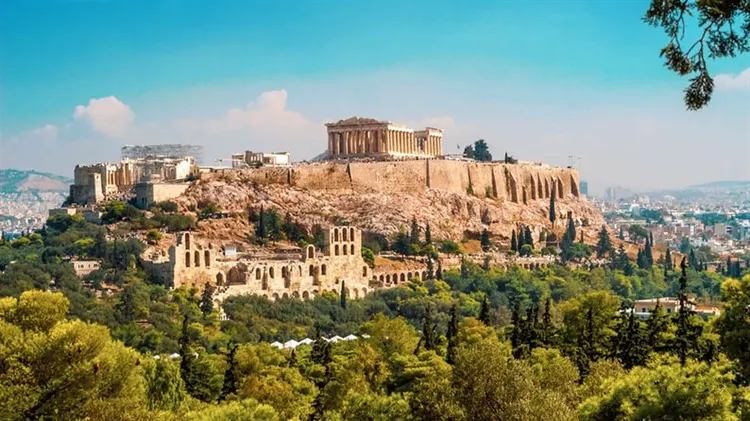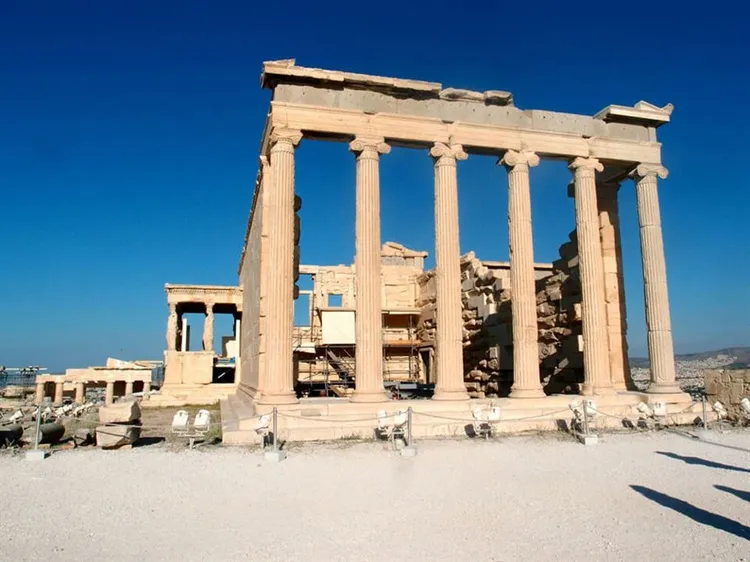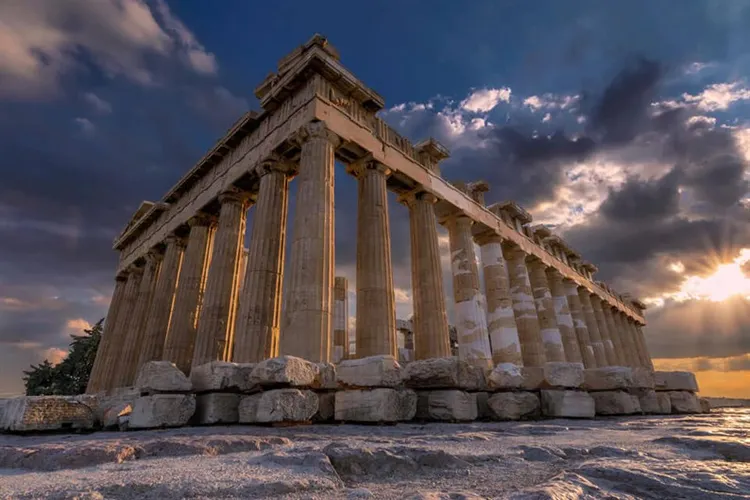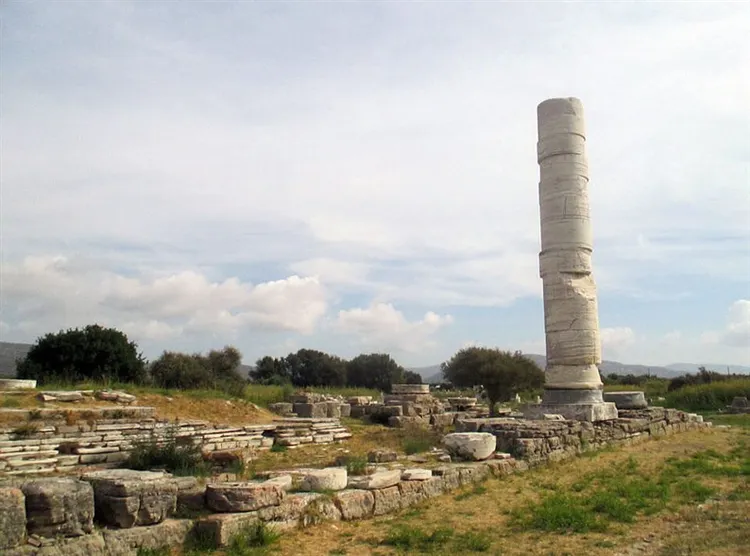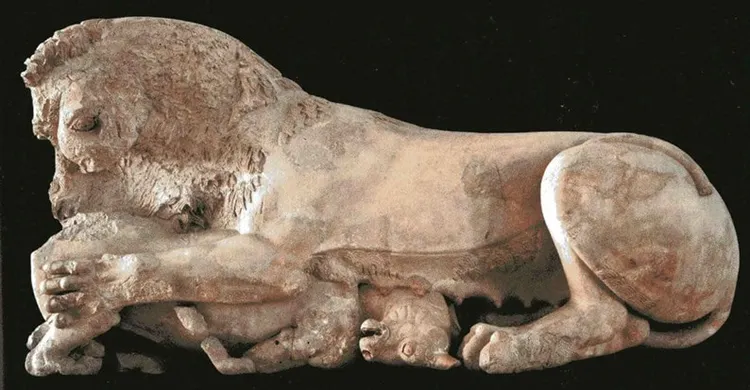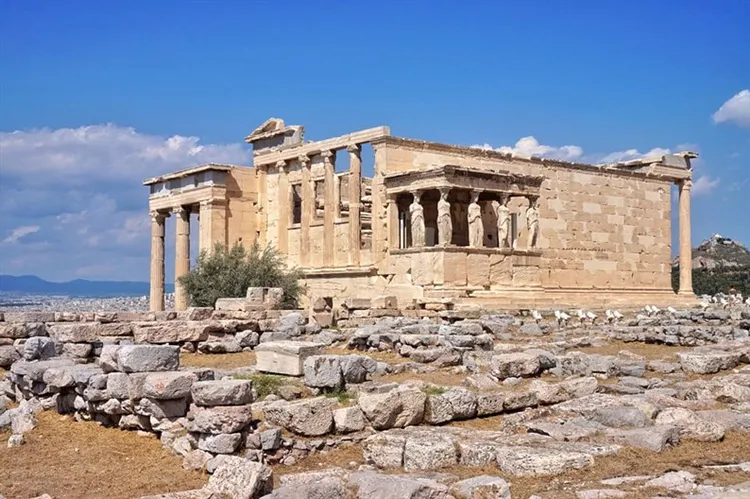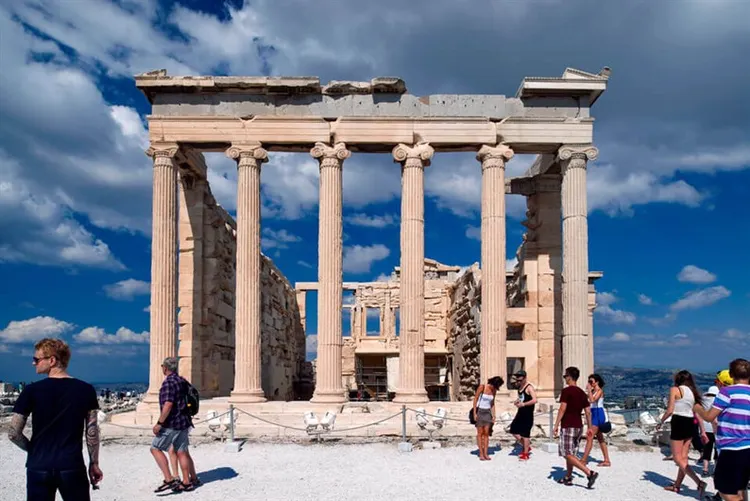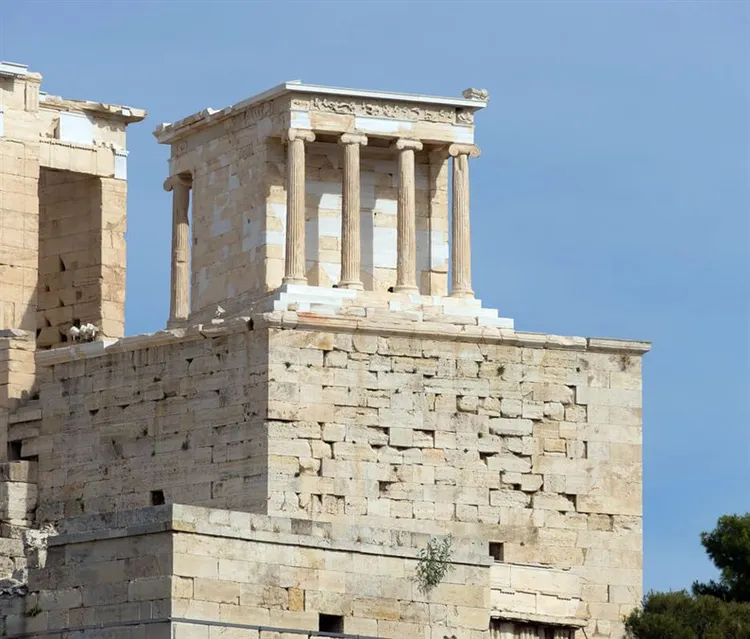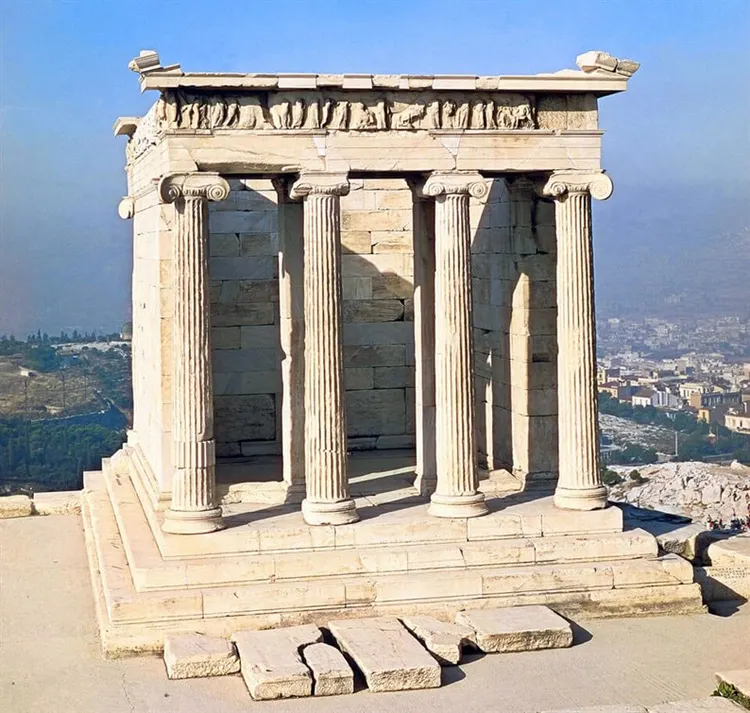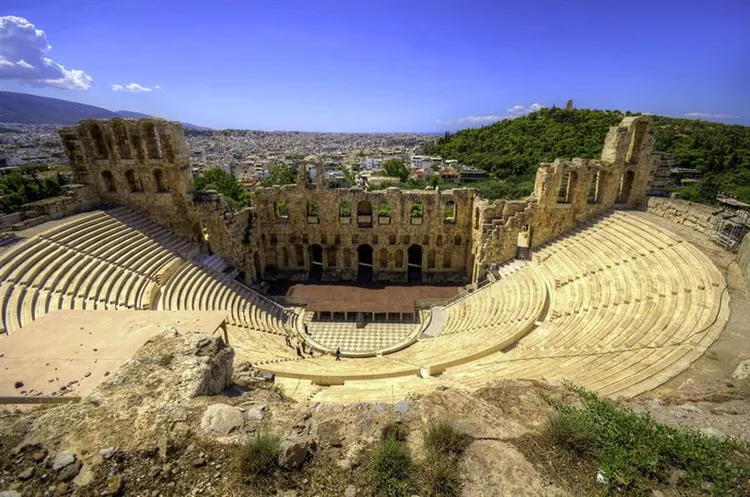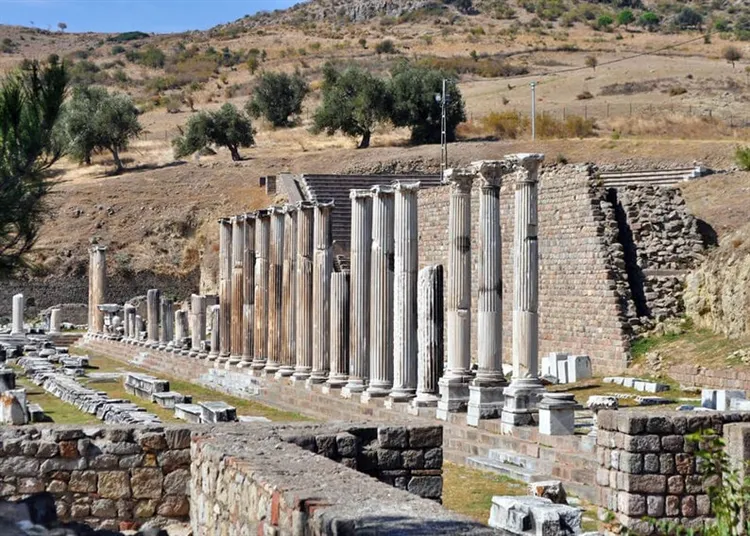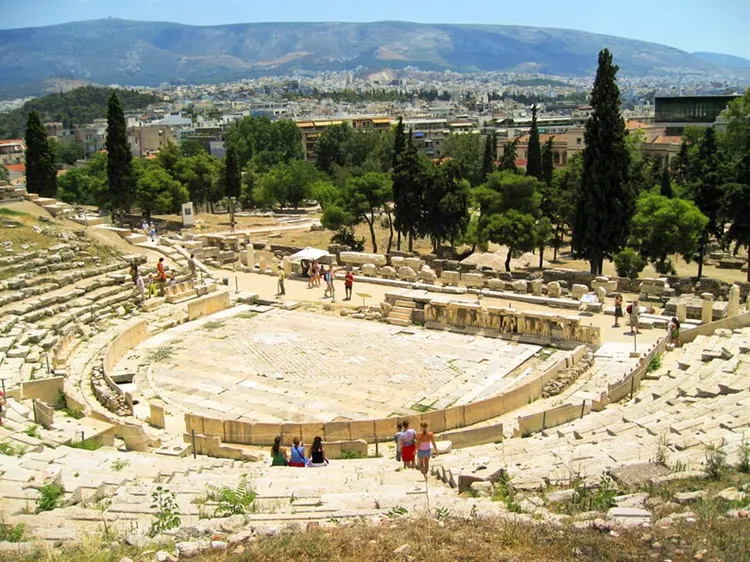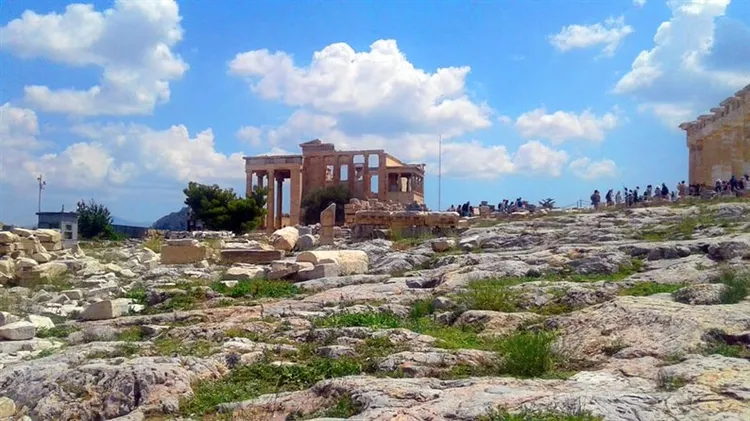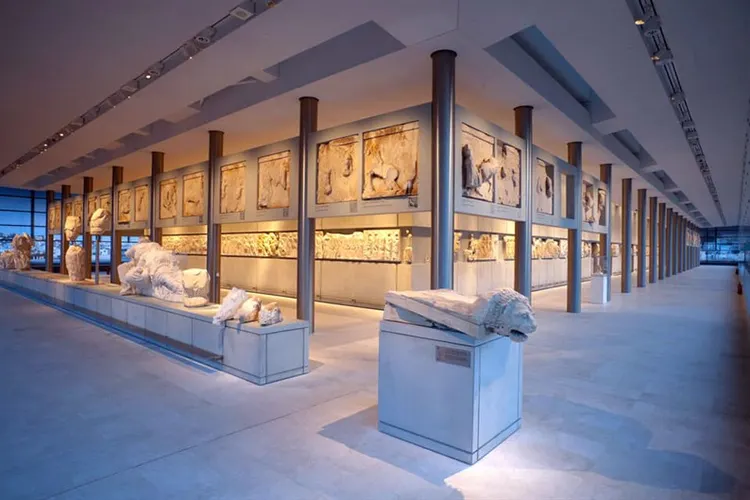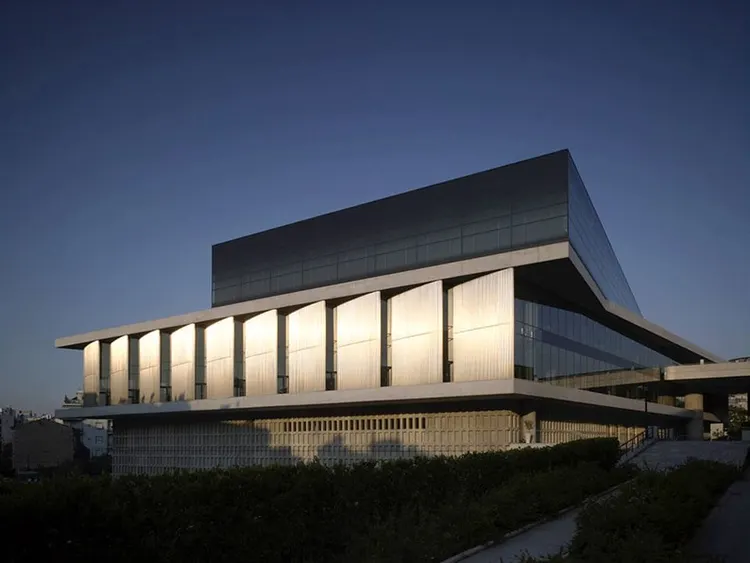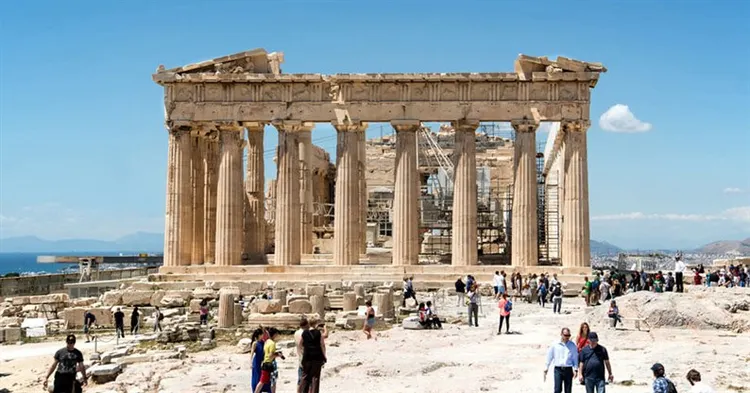The Acropolis of Athens is the most unusual building in the world. It has become a symbol of the capital of Greece. The Acropolis is visible from anywhere in Athens: the government forbade building higher buildings within the city. Therefore, tourists can use it as a guide.
Story
The Acropolis is an ancient city on a high hill. Outside the walls was the main settlement. The city was absolutely impregnable during the assault. Like any significant place in the life of the townspeople, the Acropolis is covered with legends. One of them tells that he built the city of Kekrops. He was half snake, half man. Kekrops dedicated his creation to the goddess Athena. And the first temple was erected in her honor. Kekrops hired Cyclopes to carry stones and do rough work. The buildings of Kekrops were relatively modest. Subsequently, graceful buildings decorated with gold and silver appeared in their place.
After the capture of Greece by Rome, the temples of the pagans were given to the Christians. But there were no significant changes in the architecture of the buildings: basically, the interiors were redone. The Muslim (Turkish) rule in the 15th century also did not greatly damage the ensemble: pagan, and later Christian, temples were converted into mosques without changing the architecture. The hill again retained its original appearance. But the 17th century turned out to be fatal for the Acropolis: during the siege, the Venetians fired at the ensemble from cannons. Many temples were badly damaged: they have not been restored so far.
🏨 🚕 Individual transfer from the airport to the hotel and more
The 19th century brought additional ruin to the complex: parts of the sculptural compositions were sent to the British Museum. And until now, valuable elements are there, despite the protests of the Greek government. Currently, large-scale restoration work is underway in the Acropolis. Funds for this are allocated from the state budget. Individuals also make donations. But there is still a lot to be done.
Architecture
The main construction unfolded after the victory of the Greeks over the Persians in the second half of the fifth century BC. At this time, Greek democracy led to the flourishing of the country. And to perpetuate the strength of the country, Pericles decided to rebuild the Acropolis. The place was well chosen. The hill, 156 m above sea level, is a hill of gray-blue limestone. It is absolutely impregnable: rocks protect it from three sides, and the sea from the fourth. To perpetuate the project, the architects were given the opportunity to develop a new style: a combination of Doric and Ionic. This synthetic style was to become the same for all Hellas.
The architects presented unexpected solutions when creating the ensemble:
- Volumetric vision of buildings. If you look from the side of the main entrance, then 3 walls of the temple are presented to the review.
- composition asymmetry.
- Allocation of temples in space by building an order colonnade.
- Orders allow you to split the space, or connect it. At this time, the Corinthian order began to be widely used, which became the hallmark of Hellenic architecture.
Of course, large-scale work required large financial investments:
- For the implementation of the construction, the services of expensive architects were required: Phidias, Kallikrates, Iktin and Mnesicles.
- Craftsmen were involved in constant work.
- Marble, gold, precious and semi-precious stones were used for decoration.
The large-scale idea of Pericles was not met favorably by everyone. Athens received money from other cities to maintain the army and navy, since Athens was obliged to protect its neighbors. But there was an inappropriate use of funds: finances were directed to the construction of the Acropolis. And the craftsmen were unhappy with the mandatory participation in the project. To all objections, Pericles stated that from the moment the money was provided, Athens would dispose of it at its discretion, because neighboring cities did not give warriors and sailors to the army. The purpose of creating the ensemble was achieved: the new complex retained its protective functions and at the same time glorified Athens and the ruler Pericles. Tourists still admire the magnificent temples.
What to see
In the Acropolis, many temples have already been restored: tourists can admire the work of ancient and modern masters. But some of the buildings are just awaiting restoration. Inspection of the complex should begin with those buildings that have been returned to their original appearance.
Parthenon
This temple was and remains the main one in the ensemble. It is dedicated to the goddess Athena and was built instead of the Hekadompedon temple destroyed during the siege of the city by the Persians. Construction work began in 447 BC, and the consecration took place in 438 BC. The interior decoration was completed only in 432 BC. It is noteworthy that Pericles personally supervised all the work, although he designed the temple of Iktin, and Kallikrates controlled the progress of construction.
Building features:
- The temple was erected on a pedestal of 3 steps, the height of which is 1.5 m. The walls rest on 2 steps.
- The entrances to the Acropolis and the Parthenon are opposite each other. In order to enter the temple, you need to go around it.
- The statue of Athena was in the eastern part of the Parthenon. There was also an altar.
- In the western part there was a state archive, offerings to Athena the Virgin were stored.
- Immediately after construction, the temple was snow-white. But over time, the marble acquired a noble yellowness.
- The Parthenon is a block building. Marble blocks were fastened with iron rods, and for a special fortress, the joint was filled with lead.
The Parthenon looks perfectly straight, all joints seem to be made at 90 degrees. But this is an optical illusion. Iktin knew about the peculiarities of the human eye to distort perspective, so there is not a single straight line in the Parthenon:
- To prevent the massive building from looking heavy, Iktin placed the stylobate on a raised platform.
- So that the temple would not hang over the visitor who entered, the building was shifted to the east relative to the center of the Acropolis. This gives the effect of a gradual elevation of the building.
- To prevent the columns from appearing too fragile, they were made thicker in the middle.
- So that the building does not seem heavy, the columns were slightly tilted towards the center.
- To give the appearance of solidity of the building, the columns in the corners are much thicker than the rest.
- To make the temple seem light, the distance between the columns gradually increases from the edges to the center.
These findings of Iktin were revolutionary for that time. But today they are used by architects in their projects.
Hecatompedon
Hekatompedon is a temple dedicated to Athena. Until 480 BC it was the main temple of the state. It stood for only a few decades, and then was destroyed during the siege of the city by the Persians. Archaeologists have established that the building was built during the reign of Pisistratus. The remains of the foundation show that the building was quadrangular. It was decorated with columns around the entire perimeter. Hekatompedon means “one hundred feet”, “consisting of one hundred steps.” It was located at the highest point of the hill. And every visitor, first of all, saw Hekatompedon. The entrance to the main temple was opposite the Propylaea, the main entrance to the Acropolis.
Interesting! On the site of Hekatompedon in earlier times there was an altar to the goddess Athena. It is noteworthy that part of the Parthenon is called the Hecatompedon.
Hekatompedon was destroyed by the Persians on the orders of King Xerxes. He was irritated by the long siege and the courage of the city's defenders. Xerxes wanted to destroy the very memory of the state. After the end of the war with the Persians, the Athenians did not begin to restore the destroyed Hekatompedon. Moreover, the surviving fragments were used in the construction of the Parthenon. Therefore, archaeologists cannot reliably restore the appearance of Hekatompedon. But during the excavations, perfectly preserved statues were found.
They were made of porous limestone and painted with bright colors:
- The composition of the Battle of Hercules and Triton depicts the end of the struggle: Hercules won, Triton was defeated.
- Tritopator – a three-headed snake, the patron saint of Attica. God is triune: he holds a bird (a symbol of air), a flame (fire), a ribbon (a symbol of water). Tritopator's eyes are painted green, hair is blue, torsos are pink, and tails are striped blue and red.
- A lion tearing a bull. This is not typical for Greece: such scenes are typical for Persia or Babylon.
- The battle of the gods with the titans. This composition is the worst preserved.
Sculptural compositions are exhibited in the Acropolis Museum. There, they are provided with the required conditions of safety.
Erechtheion
To the north of the main temple of the Acropolis, the Parthenon, there is a unique structure – the Erechtheion. It is named after the Hellenic king Erechtheus. The creation of the temple is reflected in the legend. Once Poseidon and Athena argued which of them would patronize Hellas. The one who brought the most valuable gifts to the inhabitants became the main one. Poseidon hit the mountain with a trident: a source of salt water flowed from the rock. Athena struck the ground with her spear: an olive tree instantly grew. And the gift of the Virgin turned out to be the most significant for the Hellenes. The temple was built next to the legendary tree, and the source was inside the building.
The initiator of the creation of the Erechtheion was Pericles, but the work was completed after the death of the king.
The project was designed by the architect Mnesicles. He also created the Propylaea, the main entrance to the Acropolis. But not everything went smoothly: the start of construction (421 BC) coincided with the war that Athens waged against Sparta. There was no longer enough finance and labor to support the construction. However, the work was completed in 406 BC.
After the consecration, objects significant for the Athenians were transferred to the Erechtheion:
But the Athenians prayed in the Erechtheion for only 1.5 years: Sparta and her allies, the Persians, won the war. Athens did not regain its power.
Interesting! During the destruction of the Acropolis during the Persian wars, the olive donated by Athena burned down. But then she grew up in the same place without human intervention.
The Erechtheion amazes tourists with its unusual architecture:
- The platform where the Erechtheion stands is uneven, so parts of the temple are located at different heights. 3 parts have separate entrances.
- In the east, there was a wooden hut of Athena. Each time, after the Panathenaic Games ended, the women brought a new peplos to the statue. In return, Athena Poliada guarded the city from the armies of enemies.
- King Erechtheus is buried in the western part, so funeral rosettes are carved above the entrance. There are also altars for offerings to Poseidon, Hephaestus and Booth. This part is lower than the eastern one by as much as 3 meters.
- In the western part there is also a portico of the daughter of Kekrops, Pandrosa. Caryatids are carved from marble quarried from Mount Pentelikon. Their height is more than 2 m. Usually, temples dedicated to Artemis were decorated with caryatids. But when planning the Acropolis, they decided not to erect such a building, so an unusual portico was attached to the Erechtheion in order to propitiate Artemis.
Until the arrival of Christianity in Athens, the Erechtheion remained active. Then the temple of the Most Holy Theotokos was located in it. After the arrival of the crusaders, the palace of the Duke of Athens was arranged here. After the conquest of Athens by the Turks, a harem was located in the Erechtheion. During the siege by the Venetians, the Erechtheion was damaged by shelling. And in the 19th century, some of the statues were taken to the UK, some were destroyed. Therefore, it is impossible to restore the Erechtheion at the moment.
Temple of Nike Apteros
This building is located outside the Acropolis. Previously, there was a fortified bastion at this place, and in order to make it convenient for the soldiers to bring gifts, the altar of Athena Nike was also installed here. In the 6th century BC. Instead of an altar, they built a temple to Athena. But after the fall of the city, on the orders of Xerxes in 480 BC. this building was destroyed. During the reign of Pericles, the state reached its peak of power. And the restoration of the Acropolis began. The project of the temple of Athena Nike was developed by Callicrates, and approved by the general meeting of the inhabitants of the city in 449 BC.
It is not known when construction began, but the consecration took place in 421 BC. 500 years after the construction, the temple unexpectedly received a new name. This is due to the mistake of the historian and traveler Pausanias. He mistook a statue of Athena without the usual military attire for a statue of Nike, but without wings. Pausanias even came up with a story that the builders specially tore off Nika's wings so that victory and good luck would not fly away from them. Naturally, after 500 years there was no one to correct Pausanias. And the random name stuck.
The architectural composition of Niki Apteros is unusual:
- The building has 2 facades. One is facing the Parthenon, and the other is facing the Propylaea.
- The base of the temple is a platform of three steps.
- 3 walls are decorated with images of the battles of the Athenians with the Persians, and the fourth – a meeting of the gods, watching the battle.
- Athena, along with Zeus, is depicted in the center. The appearance of the goddess is unusual: she took off her helmet and holds it in her hand, in the second hand is a pomegranate fruit.
Nika Apteros was destroyed during the siege of the fortress by the Venetians. Greece achieved independence in the 19th century. The restoration of the Acropolis began. But the first restoration was carried out without preparation, so the newly rebuilt building did not match the original. In the 20th century, cracks appeared in the foundation. The building was demolished, the foundation was strengthened. The second restoration was more successful: new fragments were added. The final restoration was carried out at the beginning of the 21st century. Now the temple is fully consistent with the descriptions of historians.
Odeon of Herod the Attic
This is an ancient theater built by Herodes Atticus to commemorate his dead wife. Approximate period of construction: 160-174. Before that, there were already 2 odeons in Athens.
Building features:
- Inside, the building is made of rough-hewn stone, and outside – of perfectly hewn Parian marble.
- The rounded auditorium is carved into the rock of the Acropolis hill. The diameter of the hall is 76 m. It is divided into 2 sectors, each with 32 rows. Armchairs are made of white Parian marble.
- The roof is made of Lebanese cedar. It does not have internal vertical supports, although its radius is more than 30 m.
- Lined with white marble slabs, the orchestra is semicircular.
- The stage wall had 3 levels. The first had 2 entrances, while the second and third had windows and niches for statues.
- In the east, the odeon adjoined the stoa of Eumenes.
Archaeological excavations have shown that the odeon was used not only for concerts, but also for gladiator fights. The Odeon of Herodes Atticus began to be restored in the 19th century. Now you can get into it only on the days of performances with a pre-purchased ticket.
Asclepius
This is a very unusual building. On the one hand, the building is dedicated to the god Asclepius, on the other hand, it is a place for curing the sick. The temple was built on the initiative of Telemachus. The new god (Asclepius) had an earthly incarnation of a snake. He stayed in the temple of Demeter until he got his own house. The location of the structure is the southern slope of the Acropolis next to the source of clean water. This is no coincidence: in the process of treatment, water was important.
The complex included:
The temple was decorated with images of Asclepius himself, his children, including the daughters of Hygiene and Panacea. Those who came for healing had to donate something to God. It could have been a rooster. After healing, it was required to make a sacrifice again: money, jewelry, dishes. Sometimes cured organs carved from precious woods or stones were brought as gifts.
Interesting! In this Asklepion, the priests kept a daily record of offerings. From these records, historians have established what operations and procedures were performed by doctors.
The temple was repeatedly damaged, but immediately restored. After the arrival of Christianity in Greece, Asklepion was rebuilt as a temple in honor of the Savior and Orthodox healer saints. During the Turkish rule, Asklepion turned out to be useless to anyone, it began to collapse. Restoration work is currently underway.
Theater of Dionysus
Pisistratus loved the god of wine and fun. It was he who ordered that the temple of Dionysus be built on the Acropolis hill. The building was decorated with a statue of a god made of bone and gold. A platform for ritual dances was arranged nearby. She became the beginning of the theater. The theater itself had no walls. Rows of chairs went up with an increase. Below sat the most distinguished visitors. The names of the spectators were engraved on the backs. The capacity of the theater was impressive: up to 17,000 spectators. At that time twice as many people lived in Athens.
At first, the theater had only religious performances, but then secular plays began to be shown. Later, the theater became an arena for gladiator fights. At this time, for the safety of spectators, a marble portico with a metal grill was built. Now the theater of Dionysus has been restored almost to the end. The funds were allocated from the state budget of Greece. Individuals and institutions also provided donations.
Destroyed objects
The restoration of the Acropolis is far from complete. But even the ruined buildings are interesting to see. Worth to visit:
- Halkoteka. In this special place, attributes for festive ceremonies in honor of Athena were kept.
- Temple of Zeus. It is quite small, it consisted of two halls: one was intended for gifts, rituals were performed in the second.
- Temple of Aphrodite. The ruins are decorated with images of doves and garlands.
- Temple of Artemis. The colonnade and statues of the goddess have been preserved.
- Temple of Augustus. It is dedicated to the Roman Emperor. The structure is small, the perimeter is decorated with columns.
The process of restoration and restoration is slowed down by the fact that excavations are still being carried out on the territory of the Acropolis.
Old Acropolis Museum
In order for visitors to get acquainted with all the exhibits found on the territory of the Acropolis, the Acropolis Museum was organized in 1878. At that time, a small building near the Parthenon seemed to suffice. But the number of items grew, and soon the exhibits no longer fit in 9 rooms. Scientists have criticized the Greek authorities for the fact that the unique collection is located in an earthquake-prone area and is at risk. Therefore, it was decided to build a new Museum.
New Acropolis Museum
The new Acropolis Museum opened in 2009. The building was built 300 meters from the wall enclosing the Acropolis. The author of the project is the Swiss Bernard Chumi. It is noteworthy that the building has a glass floor and walls. As conceived by the architect, this way tourists will better immerse themselves in the atmosphere of the ancient world. The platform at the top allows you to admire the Acropolis without leaving the Museum. The main collection consists of statues that were found during excavations. The required temperature and humidity have been created for unique exhibits. They are controlled by automation.
Important! A visit to the Acropolis Museum is paid separately. The entrance ticket does not entitle you to enter the Acropolis.
Interesting Facts
It is known that the Turks besieged in the Acropolis fortress needed lead. They began destroying buildings to extract metal from fasteners. But the Hellenes did not allow such barbarity and sent the enemies the lead they were looking for. The human eye has the ability to distort perspective. The architect Iktin distorted reality as much as possible and got an allegedly perfect Parthenon. The Hellenes were great originals: first they killed the god Dionysus, accusing him of attempting to poison, and then, appreciating the quality of the wine, they built a temple in honor of Dionysus. New, opened in 2009, the Acropolis Museum is the third in a row. Its area is 10 times larger than that of its predecessors.
Excursions
Some tourists prefer to explore the Acropolis on their own. But this will take more than one day. It is much more reasonable to take an experienced Russian-speaking guide. The escort will introduce you to the legends of the Acropolis, making the walk unforgettable. Tours are group and individual. The time is selected taking into account the wishes of the tourists.
Opening hours and ticket prices
You can get to the territory of the Acropolis every day from 8 am to half past six in the evening. Admission fee: 12 euros. But citizens of the European Union enjoy benefits: pensioners and schoolchildren buy a ticket for half the price – 6 euros. One ticket allows you to enter the territory of the Acropolis for 4 days. To view the Museum you need to pay an entrance fee. The price is 1 euro.
There are days when you can visit for free:
- Memorial Day – 18 April.
- World Environment Day – 5 June.
- Memorial Day actress Mercury.
- Last weekend of September.
Closed to visitors on Holy Sunday of Christ, Christmas, the first day of the New Year.
Where is it located and how to get there
The Acropolis is located in the western part of Athens. It is most convenient for tourists to get to the hill by metro. Get off at the Acropolis station. Trolleybuses 1, 5, 15 or buses 135, 106, 208 go to the same stop.
